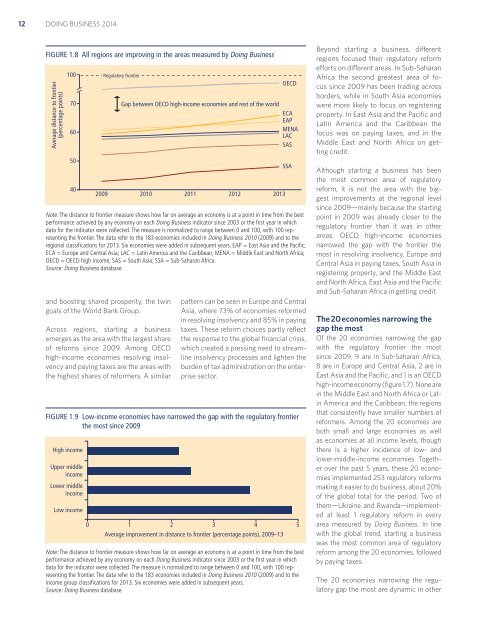1gGgw9ScK
1gGgw9ScK
1gGgw9ScK
Create successful ePaper yourself
Turn your PDF publications into a flip-book with our unique Google optimized e-Paper software.
12<br />
DOING BUSINESS 2014<br />
FIGURE 1.8 All regions are improving in the areas measured by Doing Business<br />
Average distance to frontier<br />
(percentage points)<br />
100<br />
50<br />
40<br />
Regulatory frontier<br />
70 Gap between OECD high-income economies and rest of the world<br />
ECA<br />
EAP<br />
60<br />
MENA<br />
LAC<br />
SAS<br />
2009 2010 2011 2012 2013<br />
and boosting shared prosperity, the twin<br />
goals of the World Bank Group.<br />
Across regions, starting a business<br />
emerges as the area with the largest share<br />
of reforms since 2009. Among OECD<br />
high-income economies resolving insolvency<br />
and paying taxes are the areas with<br />
the highest shares of reformers. A similar<br />
OECD<br />
Note: The distance to frontier measure shows how far on average an economy is at a point in time from the best<br />
performance achieved by any economy on each Doing Business indicator since 2003 or the first year in which<br />
data for the indicator were collected. The measure is normalized to range between 0 and 100, with 100 representing<br />
the frontier. The data refer to the 183 economies included in Doing Business 2010 (2009) and to the<br />
regional classifications for 2013. Six economies were added in subsequent years. EAP = East Asia and the Pacific;<br />
ECA = Europe and Central Asia; LAC = Latin America and the Caribbean; MENA = Middle East and North Africa;<br />
OECD = OECD high income; SAS = South Asia; SSA = Sub-Saharan Africa.<br />
Source: Doing Business database.<br />
SSA<br />
pattern can be seen in Europe and Central<br />
Asia, where 73% of economies reformed<br />
in resolving insolvency and 85% in paying<br />
taxes. These reform choices partly reflect<br />
the response to the global financial crisis,<br />
which created a pressing need to streamline<br />
insolvency processes and lighten the<br />
burden of tax administration on the enterprise<br />
sector.<br />
FIGURE 1.9 Low-income economies have narrowed the gap with the regulatory frontier<br />
the most since 2009<br />
High income<br />
Upper middle<br />
income<br />
Lower middle<br />
income<br />
Low income<br />
0 1 2 3 4 5<br />
Average improvement in distance to frontier (percentage points), 2009–13<br />
Note: The distance to frontier measure shows how far on average an economy is at a point in time from the best<br />
performance achieved by any economy on each Doing Business indicator since 2003 or the first year in which<br />
data for the indicator were collected. The measure is normalized to range between 0 and 100, with 100 representing<br />
the frontier. The data refer to the 183 economies included in Doing Business 2010 (2009) and to the<br />
income group classifications for 2013. Six economies were added in subsequent years.<br />
Source: Doing Business database.<br />
Beyond starting a business, different<br />
regions focused their regulatory reform<br />
efforts on different areas. In Sub-Saharan<br />
Africa the second greatest area of focus<br />
since 2009 has been trading across<br />
borders, while in South Asia economies<br />
were more likely to focus on registering<br />
property. In East Asia and the Pacific and<br />
Latin America and the Caribbean the<br />
focus was on paying taxes, and in the<br />
Middle East and North Africa on getting<br />
credit.<br />
Although starting a business has been<br />
the most common area of regulatory<br />
reform, it is not the area with the biggest<br />
improvements at the regional level<br />
since 2009—mainly because the starting<br />
point in 2009 was already closer to the<br />
regulatory frontier than it was in other<br />
areas. OECD high-income economies<br />
narrowed the gap with the frontier the<br />
most in resolving insolvency, Europe and<br />
Central Asia in paying taxes, South Asia in<br />
registering property, and the Middle East<br />
and North Africa, East Asia and the Pacific<br />
and Sub-Saharan Africa in getting credit.<br />
The 20 economies narrowing the<br />
gap the most<br />
Of the 20 economies narrowing the gap<br />
with the regulatory frontier the most<br />
since 2009, 9 are in Sub-Saharan Africa,<br />
8 are in Europe and Central Asia, 2 are in<br />
East Asia and the Pacific, and 1 is an OECD<br />
high-income economy (figure 1.7). None are<br />
in the Middle East and North Africa or Latin<br />
America and the Caribbean, the regions<br />
that consistently have smaller numbers of<br />
reformers. Among the 20 economies are<br />
both small and large economies as well<br />
as economies at all income levels, though<br />
there is a higher incidence of low- and<br />
lower-middle-income economies. Together<br />
over the past 5 years, these 20 economies<br />
implemented 253 regulatory reforms<br />
making it easier to do business, about 20%<br />
of the global total for the period. Two of<br />
them—Ukraine and Rwanda—implemented<br />
at least 1 regulatory reform in every<br />
area measured by Doing Business. In line<br />
with the global trend, starting a business<br />
was the most common area of regulatory<br />
reform among the 20 economies, followed<br />
by paying taxes.<br />
The 20 economies narrowing the regulatory<br />
gap the most are dynamic in other



